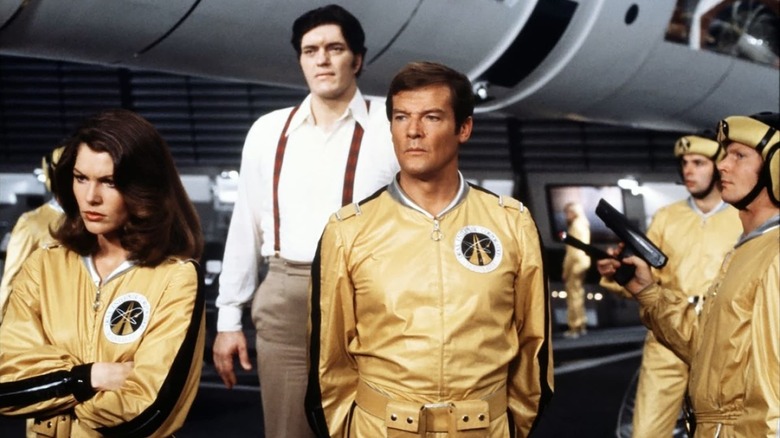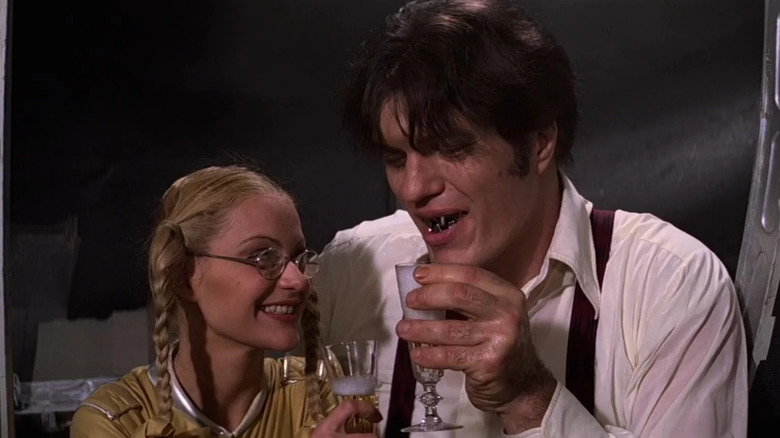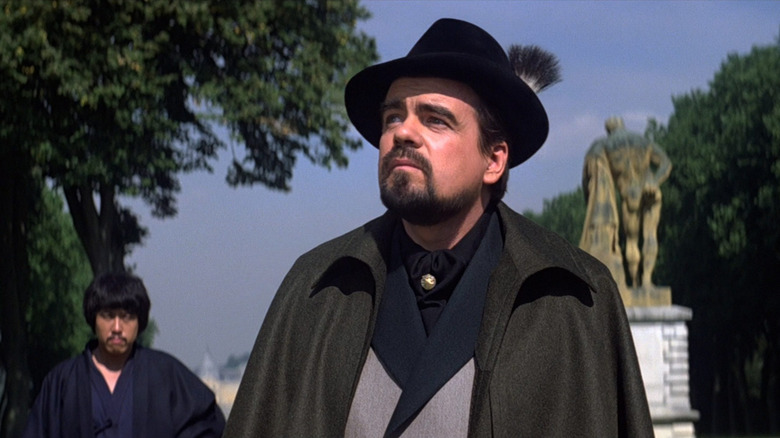James Bond's Creator Wrote A Script For The Franchise's Silliest Film — And It Was Lost For Decades
There is a moment in "Live and Let Die" that sets the tone for Roger Moore's entire run as James Bond. Left for dead on an island in the middle of a pond full of hungry crocodiles, Moore's 007 makes his escape by using three of the deadly reptiles as stepping stones to safety, barely getting his feet wet in the process. There's plenty more where that came from, including the barrel roll car jump in "The Man With the Golden Gun," Blofeld being dumped down a smokestack in "For Your Eyes Only," and the snowboarding scene set to The Beach Boys in "A View to a Kill." But perhaps no film in Moore's tenure is as end-to-end silly as "Moonraker."
After the success of "The Spy Who Loved Me," Moore's next adventure was supposed to be "For Your Eyes Only." (There's even a "James Bond will return..." teaser in the closing credits of the former movie.) But then "Star Wars: Episode IV — A New Hope" hit theaters and suddenly every major studio was scrambling to cash in on the success of George Lucas's wildly popular space opera. Producer Albert "Cubby" Broccoli decided Eon Productions should also follow suit to keep up with the competition and turned to Ian Fleming's most space-sounding Bond novel, "Moonraker," for inspiration.
This time, Bond was going off-planet to thwart the evil schemings of one Hugo Drax (Michael Lonsdale), an industrialist who aims to wipe out everyone on Earth from his space station and establish a master race. As that wasn't ridiculous enough, Jaws (Richard Kiel) also returned from the previous film and got a girlfriend, and there were plenty of jokey moments like the double-taking pigeon in the Venice gondola chase. Audiences ate it up, however, and "Moonraker" became the highest-grossing Bond movie until "Goldeneye" in 1995.
Despite its success, "Moonraker" is regarded as one of the worst Bond movies (and almost certainly the silliest). Yet, it might have been much different if Fleming had gotten his way. Before he died in 1964, the author wrote a film treatment based on his original novel. It was considered lost for almost 50 years before it re-emerged in 2015 and was sold at auction to a private bidder. Details are scarce, but it's safe to say it was closer in tone to the "Moonraker" novel than the 1979 film adaptation. Here's what we know.
Ian Fleming's Moonraker novel was surprisingly grounded
"Moonraker" was Ian Fleming's third James Bond novel and, despite the title, it's a very Earth-bound story. Set entirely in Britain, James Bond is assigned to investigate Sir Hugo Drax, a respected industrialist and former British war hero. Drax is using Nazi V2 rocket technology to develop the Moonraker program, which is designed to protect the country from incoming attacks. Eventually, Bond discovers that Drax is actually an ex-Nazi scientist working undercover for the Soviet Union and plans to arm his rocket with a nuclear warhead to destroy London.
Published in 1955, "Moonraker" tapped into painful memories of V1 rocket attacks on the English capital during World War II and growing fears of nuclear annihilation as Cold War tensions escalated. These concerns were very real for the public as the atomic devastation of Hiroshima and Nagasaki 10 years earlier was still fresh in many people's minds. The novel was received as a surprisingly somber meditation on the decline of the British Empire, as well as what the nation stood to lose if a catastrophic conflict broke out so soon after the last one. Fleming's development of Bond's character was acclaimed while Drax was also praised for being one of the most believable Bond villains (one with real-world equivalents who presented a genuine threat). Some fans weren't so thrilled, though, and were disappointed by the lack of exotic locations that provided an escape for British readers who rarely got to see destinations beyond their shores in real life.
Although some regard "Moonraker" as Fleming's masterpiece, Cubby Broccoli wasn't so enthused. Even after Eon Productions belatedly used it to cash in on the "Star Wars" phenomenon, he dismissed the book's plot as "a little piddling rocket that went up to destroy London." Clearly, the scope needed to be bigger for an international blockbuster. Christopher Wood's screenplay only took the title and basic elements of Fleming's story before expanding it to encompass space stations and global genocide at the hands of Drax, who became a more standard Bond villain with designs on world domination.
What we known about Ian Fleming's Moonraker screenplay
Ian Fleming wrote from experience when he created James Bond, drawing from his first-hand knowledge of British Intelligence during World War II. He considered spy work a "dirty trade" and his most famous character was accordingly gritty, a cold-hearted killer whose penchant for life's finer things served as a balm in a profession where he might meet an ugly end at any moment. In short, Fleming's 007 could hardly be more different from Roger Moore's light-hearted take.
Fleming conceived "Moonraker" as a novel that would eventually find its way into cinemas and wrote his 150-page film treatment a year after the book was published. With "Dr. No," the first big-screen adaptation still six years away, details indicate that it was a far more low-key affair than even Sean Connery's relatively grounded adventures. It was Fleming's only attempt at a screenplay and Jon GIlbert, a Fleming expert, has noted that it is rather heavy on the prose and "much more serious" than the 1979 movie.
Major differences from the franchise we know and love include the absence of M and Miss Moneypenny. Bond's commanding officer is presented as a genial civil servant, probably more like the secret service bosses Fleming knew during his time with Naval Intelligence. Jaws is also nowhere to be seen: Richard Kiel's memorable steel-toothed henchman appeared as an equivalent villain called Sol "Horror" Horowitz in Fleming's later novel, "The Spy Who Loved Me." Another inclusion in the Fleming screenplay was an all-new character called Tosh, a special agent working undercover as a Cockney card sharp.
One detail that Bond fan would appreciate is 007's choice of swimwear. Like Sean Connery and Daniel Craig, Fleming's Bond wears light blue shorts while taking a dip off the coast of Kent. With the discovery of Fleming's screenplay and constant rumors about which direction the Bond franchise might take in future, it begs an intriguing question: Might we one day get a reboot of "Moonraker" closer to how its author originally imagined it?


